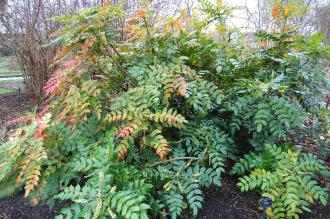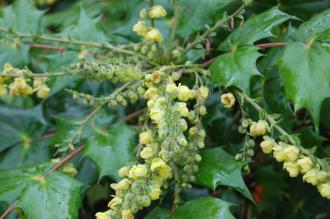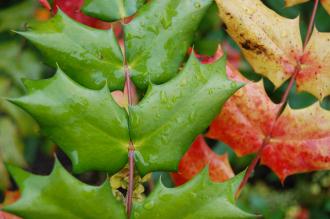
Mahonia japonica (09/02/2013, Kew Gardens, London)
Position: Partial shade to full shade
Flowering period: Autumn to early spring
Soil: Moist, well drained
Eventual Height: 2m
Eventual Spread: 3m
Hardiness: 6a – 9b
Family: Berberidaceae
Mahonia japonica iis an evergreen, shrub with a rounded bushy habit. Its dark green, leathery leaves are pinnate, composed of up to 9 leaflets, up to 40cm long, these often become red/ purple during the winter months. Its leaflets are opposite, very spiky and up to 10cm long. Its fragrant pale yellow flowers are borne on terminal racemes and up to 25cm long. Its blue/ black fruit follow the flowers in the form of berries.

Mahonia japonica Flower (09/02/2013, Kew Gardens, London)
Mahonia japonica, commonly known as Japanese Mahonia, is native to north east China an not Japan as its name would suggest.
The etymological root of the binomial name Mahonia was named by Thomas Nuttall after an Irish political refugee, Bernard M’Mahon. Japonica is derived from the Latin meaning ‘from Japan’.
The landscape architect may find Mahonia japonica useful in shady locations including woodland planting schemes. It may be used as an impenetrable informal hedging plant. Once established this shrub is drought tolerant. This shrub is not attractive to deer.
Ecologically, Mahonia japonica flowers are attractive to pollinating insects. Its berries are eaten by birds.
The Royal Horticultural Society has given Mahonia japonica their prestigious Award of Garden Merit in 1993.

Mahonia japonica Leaf (09/02/2013, Kew Gardens, London)
Mahonia japonica prefers moist, humus rich, well-drained soils. It tolerates most pH of soil.
Mahonia japonica requires little maintenance. Some stems may be removed in May to encourage bushy habit, suckers may be removed at the same time.

